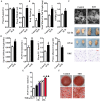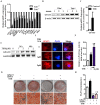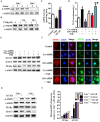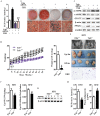Thyrotropin and obesity: increased adipose triglyceride content through glycerol-3-phosphate acyltransferase 3
- PMID: 25559747
- PMCID: PMC4284501
- DOI: 10.1038/srep07633
Thyrotropin and obesity: increased adipose triglyceride content through glycerol-3-phosphate acyltransferase 3
Abstract
Epidemiological evidence indicates that thyrotropin (TSH) is positively correlated with the severity of obesity. However, the mechanism remains unclear. Here, we show that TSH promoted triglyceride (TG) synthesis in differentiated adipocytes in a thyroid hormone-independent manner. Mice with subclinical hypothyroidism, which is characterized by elevated serum TSH but not thyroid hormone levels, demonstrated a 35% increase in the total white adipose mass compared with their wild-type littermates. Interestingly, Tshr KO mice, which had normal thyroid hormone levels after thyroid hormone supplementation, resisted high-fat diet-induced obesity. TSH could directly induce the activity of glycerol-3-phosphate-acyltransferase 3 (GPAT3), the rate-limiting enzyme in TG synthesis, in differentiated 3T3-L1 adipocytes. However, following either the knockdown of Tshr and PPARγ or the constitutive activation of AMPK, the changes to TSH-triggered GPAT3 activity and adipogenesis disappeared. The over-expression of PPARγ or the expression of an AMPK dominant negative mutant reversed the TSH-induced changes. Thus, TSH acted as a previously unrecognized master regulator of adipogenesis, indicating that modification of the AMPK/PPARγ/GPAT3 axis via the TSH receptor might serve as a potential therapeutic target for obesity.
Figures






Similar articles
-
Thyrotropin increases hepatic triglyceride content through upregulation of SREBP-1c activity.J Hepatol. 2014 Dec;61(6):1358-64. doi: 10.1016/j.jhep.2014.06.037. Epub 2014 Jul 10. J Hepatol. 2014. PMID: 25016220
-
Mechanism of the antiadipogenic-antiobesity effects of a rice hull smoke extract in 3T3-L1 preadipocyte cells and in mice on a high-fat diet.Food Funct. 2015 Sep;6(9):2939-48. doi: 10.1039/c5fo00469a. Food Funct. 2015. PMID: 26190448
-
Thyroid-stimulating hormone inhibits adipose triglyceride lipase in 3T3-L1 adipocytes through the PKA pathway.PLoS One. 2015 Jan 15;10(1):e0116439. doi: 10.1371/journal.pone.0116439. eCollection 2015. PLoS One. 2015. PMID: 25590597 Free PMC article.
-
The Adipocyte as a novel TSH target.Mini Rev Med Chem. 2008 Jan;8(1):91-6. doi: 10.2174/138955708783331531. Mini Rev Med Chem. 2008. PMID: 18220988 Review.
-
Thyroid hormones in the pathogenesis and treatment of obesity.Eur J Pharmacol. 2002 Apr 12;440(2-3):85-98. doi: 10.1016/s0014-2999(02)01420-6. Eur J Pharmacol. 2002. PMID: 12007527 Review.
Cited by
-
TSH Combined with TSHR Aggravates Diabetic Peripheral Neuropathy by Promoting Oxidative Stress and Apoptosis in Schwann Cells.Oxid Med Cell Longev. 2021 Nov 11;2021:2482453. doi: 10.1155/2021/2482453. eCollection 2021. Oxid Med Cell Longev. 2021. PMID: 34804362 Free PMC article.
-
Thyrotropin aggravates atherosclerosis by promoting macrophage inflammation in plaques.J Exp Med. 2019 May 6;216(5):1182-1198. doi: 10.1084/jem.20181473. Epub 2019 Apr 2. J Exp Med. 2019. PMID: 30940720 Free PMC article.
-
The Mysterious Universe of the TSH Receptor.Front Endocrinol (Lausanne). 2022 Jul 12;13:944715. doi: 10.3389/fendo.2022.944715. eCollection 2022. Front Endocrinol (Lausanne). 2022. PMID: 35903283 Free PMC article. Review.
-
Quantitative proteomic analysis of murine white adipose tissue for peritoneal cancer metastasis.Anal Bioanal Chem. 2018 Feb;410(5):1583-1594. doi: 10.1007/s00216-017-0813-9. Epub 2017 Dec 27. Anal Bioanal Chem. 2018. PMID: 29282499 Free PMC article.
-
Integrated microRNA and proteome analysis reveal a regulatory module in hepatic lipid metabolism disorders in mice with subclinical hypothyroidism.Exp Ther Med. 2020 Feb;19(2):897-906. doi: 10.3892/etm.2019.8281. Epub 2019 Dec 4. Exp Ther Med. 2020. PMID: 32010250 Free PMC article.
References
-
- Steinberger J., Moorehead C., Katch V. & Rocchini A. P. Relationship between insulin resistance and abnormal lipid profile in obese adolescents. J Pediatr 126, 690–695 (1995). - PubMed
-
- Russo P., Lauria F. & Siani A. Heritability of body weight: moving beyond genetics. Nutr Metab Cardiovasc Dis 20, 691–697 (2010). - PubMed
Publication types
MeSH terms
Substances
LinkOut - more resources
Full Text Sources
Other Literature Sources
Medical
Molecular Biology Databases
Research Materials
Miscellaneous

